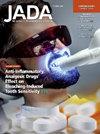一项为期4周的随机临床试验,评估一种新型振荡旋转电动牙刷对牙菌斑和牙龈炎的影响。
IF 3.5
2区 医学
Q1 DENTISTRY, ORAL SURGERY & MEDICINE
引用次数: 0
摘要
背景:许多牙龈炎患者使用手动牙刷,尽管有证据表明使用电动牙刷可以显著减少牙菌斑和牙龈炎。一款新的振荡旋转(OR)牙刷具有流线型设计和更安静的声音,手动牙刷用户可能会觉得很有吸引力。方法:这项平行组、3组随机临床研究比较了在敏感或日常清洁模式下使用的新型OR牙刷与手动牙刷在牙龈炎患者中使用4周的牙菌斑(Rustogi改良海军菌斑指数)和减少牙龈炎(改良牙龈指数和出血部位数量)。结果:3组患者在第1周和第4周牙龈炎和菌斑测量均有显著改善(P≤0.005)。两种模式下使用的OR牙刷在两个时间点上对所有牙龈炎和菌斑测量的疗效均显著高于手动牙刷(P≤0.016)。第4周,手动牙刷与OR敏感牙刷和OR日常清洁牙刷治疗在全口菌斑减少方面的差异分别为-0.05 (95% CI, -0.062至-0.037)和-0.078 (95% CI, -0.091至-0.066)。手工组中只有20%的参与者从牙龈炎(≥10%的出血部位)过渡到健康(结论:在基线牙龈炎的手动牙刷使用者中,新的OR牙刷在减少菌斑和牙龈炎方面明显比手动牙刷更有效。实际意义:OR牙刷改善了手动牙刷使用者的牙周健康结果,并被设计为将他们过渡到电动技术。该临床试验已在isrctn -英国临床研究注册中心注册。注册号为ISRCTN61582326。本文章由计算机程序翻译,如有差异,请以英文原文为准。
A 4-week randomized clinical trial evaluating plaque and gingivitis effects of a new oscillating-rotating electric toothbrush
Background
Many patients with gingivitis use manual toothbrushes, despite evidence of considerably greater plaque and gingivitis reductions with electric toothbrushes. A new oscillating-rotating (OR) toothbrush features a streamlined design and quieter sound that manual toothbrush users may find appealing.
Methods
This parallel-group, 3-treatment, randomized, clinical study compared the new OR toothbrush, used in sensitive or daily clean mode, with a manual toothbrush for plaque (Rustogi Modified Navy plaque index) and gingivitis reduction (modified gingival index and number of bleeding sites) over 4 weeks among manual toothbrush users with gingivitis.
Results
All 3 groups experienced significant improvement in all gingivitis and plaque measures at weeks 1 and 4 (P ≤ .005). The OR toothbrush used in either mode had significantly greater efficacy vs the manual toothbrush for all gingivitis and plaque measures at both time points (P ≤ .016). Week 4 treatment difference for whole-mouth plaque reduction between the manual toothbrush and OR sensitive and OR daily clean toothbrush treatments was –0.05 (95% CI, –0.062 to –0.037) and –0.078 (95% CI, –0.091 to –0.066), respectively. Only 20% of participants in the manual group transitioned from gingivitis (≥ 10% bleeding sites) to healthy (< 10% bleeding sites) vs 46.7% in the OR sensitive group and 60% in the OR daily clean group (P = .005).
Conclusions
The new OR toothbrush was significantly more effective than a manual toothbrush at reducing plaque and gingivitis in manual toothbrush users with baseline gingivitis.
Practical Implications
The OR toothbrush improves periodontal health outcomes for manual toothbrush users and was designed to transition them to electric technology. This clinical trial was registered at ISRCTN–The UK’s Clinical Study Registry. The registration number is ISRCTN61582326.
求助全文
通过发布文献求助,成功后即可免费获取论文全文。
去求助
来源期刊

Journal of the American Dental Association
医学-牙科与口腔外科
CiteScore
5.30
自引率
10.30%
发文量
221
审稿时长
34 days
期刊介绍:
There is not a single source or solution to help dentists in their quest for lifelong learning, improving dental practice, and dental well-being. JADA+, along with The Journal of the American Dental Association, is striving to do just that, bringing together practical content covering dentistry topics and procedures to help dentists—both general dentists and specialists—provide better patient care and improve oral health and well-being. This is a work in progress; as we add more content, covering more topics of interest, it will continue to expand, becoming an ever-more essential source of oral health knowledge.
 求助内容:
求助内容: 应助结果提醒方式:
应助结果提醒方式:


